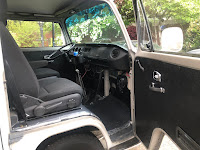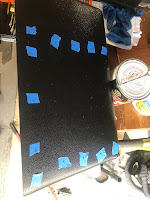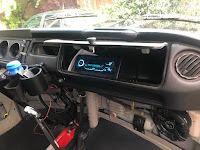After a fall/winter/spring of making modifications to Hapy, we took him for a test spin. Today's post covers that, the discoveries made and resolved and then another test drive.
The Changes
First, off, let's recap some of the changes since we last drove Hapy. Recall, that last run was a drive to Cornelius after resolving the stammer by cleaning up the vacuum lines and appliances. That was our last drive (except for the decibel tests) in those loaned-by-GratefulEd seats. We now have Sprinter seats. The old flooring was removed, CLD, jute insulation and MLV was laid in it's place. Of course, we have sound deadener all over and the stereo is operational (it was before, it's just better). On the mechanical side, the engine has a "cold" air intake now and there is a rear sway bar for handling. It is a different feel. More different, I think, is my familiarity with driving him. I have been driving GoRo (the Audi A4) and ToyoTruck, which are much more modern. So, my frame of reference is a little off and the Sprinter seats sit much higher, so I have to lean over to reach the stick now, especially when pulling away from a stop sign. I find myself hunched, and twisted to look left for oncoming traffic. Regardless, I think it will take a few drives to re-acclimate to driving the old bus. Looks like there will be more bus driving ahead. Sweet. One thing worth noting, I think: again, for the entire drive (albeit a short one), we didn't have the stereo on. Funny how much effort I put in and how little it gets used on the road. There is just something about riding in the bus that lends itself to no radio, and carrying on a conversation instead.
The Drive
On to the drive! Hapy started right up like he had been driven the day before. The throttle is super responsive, and the engine drove like a champ. He still doesn't like 2nd gear, but I haven't done anything to address that (it might be my install of the Scat short-throw shifter). The overall low-end drone is MUCH quieter, but some rattles remain, especially the screens in the jealous windows. I probably have them installed incorrectly (this video shows correct). Hapy still stops well, and he takes corners WAY better. There was almost no sway around street corners; of course, we did not drive very far nor very fast. We simply drove to a nearby park, played with the dog and returned home by way of the local c-store for some ice cream on a stick. The combo oil pressure / temp gauge still works great, and we did not throw any codes. While we didn't get above 35mph, the sound inside the bus never grew so loud that we couldn't talk at a conversational level. We could not hear the hum of the tires at all, and we really did not notice the sound of the engine. We could hear it, sure, but it was not as ever-present as it used to be. Recall, I used to describe the noise while driving the bus like sitting in an old metal shed next to a running a diesel generator, in a wind-storm. It is definitely not like that around town. I will execute a full decibel test lap to test the noise at highway speeds, but first, there are some things to fix.
The Issues
First, the exterior lights continue to produce phantoms. The brake pedal causes a bunch of the exterior lights (like the front running lights?) to light up, but not both brake lights. Also, the turn signal doesn't work when the brake pedal is pressed. No pedal and no running lights on... and the blinkers work. I remembered that I had the exact same experience when I took Hapy on that decibel test drive (buried in the Hapy Noises - Part 2 post). So, nothing I did over the winter caused it, but nothing fixed it either.
Probably equally important, the fan switch no longer triggered the fans to fire up. After we returned home, I found that one of my wiring bits had become disconnected. While repairing, I noticed how hot the wires would get during testing, and decided that I had gone too thin a gauge in some areas. So, I replaced the merged fan ground wires with individual 14ga grounds, and improved the supply-side to 14ga as well. The fans now both work, and the wires are air temperature.
The speedometer didn't work. I must have disconnected the speedo to get into the dash at some point over the winter that I don't remember and failed to reconnect it. This took no brainpower, just lots of patience opening up the dashboard, and trying not to upset any of the wiring back there.
We dropped into that awful 1200RPM limp mode right before we shoved off, but it only happened that one time. Believing I had fixed that before, this was especially frustrating. I must have bumped the wiring connection at the pedal while installing the jute and MLV. I checked those connections (pressing the joint-points firmly between my fingers), but nothing felt off. After multiple drives since, Hapy has not dropped into that 1200RPM limp mode again.
Last, Hapy had not yet received his annual Spring cleaning (after-photo is at the top). So, he had a blanket of pollen on his pop top, moss on his window seals / windshield wipers, dull looking paint and dirty windows. The spring wash is the biggest of the year, taking a couple of hours, but it is so worth it.
Exterior Lighting Diagnosing
I have tried so many times to figure this out, and so many ways, but I had not been successful. I won't list them, but between resistance and voltage testing everywhere, running test wires the length of the bus, and replacing things, I thought I had tried everything. This weird brake light thing had been a recurring phantom for years, practically since I first did the engine swap. One of the frequent causes for the issue to return after being gone for a while was a remove/install of the battery. This always seemed strange. Sure, the battery is part of the electrical system, but why would it re-conjure an electrical ghost? It occurred to me this time around that the old 20-pin diagnosis plug is back by the battery. Perhaps my incomplete removal of that plug and related wires is a contributing factor?
Unable to determine this through my prior methods, I did something completely different. I removed the tail light assemblies from the bus, letting them loosely hang in the body holes. I took a different 12V auto battery, and ran a test wire from its ground post to the body ground point next to the main on-board battery. Using a fused wire, I touched various light circuits to see which ones worked as expected and which did not. All of this time, I had believed the issue was in the passenger tail-light: it is the light fixture closest to the battery, so I thought I was bumping something while installing the battery. Nope. The tail-light circuits would fire the correct lights. When I ran the same test on the passenger light fixture, lights were batty like I described above.
I checked the wiring diagram related to the driver tail light, and noticed that there was a tie-in between it and the battery location: the old test plug circuit. The yellow circled 9, 10 and 12 which tie into the driver tail light all correspond to the pin numbers in the plug. I knew that the running light was the one that was lighting up in-error, so I figured that red wire was the compromised one. I cut it off at the tail light, and the phantom behavior ended. Both brake lights illuminate when I step on the brake pedal, and all the running lights light up correctly (and only when I turn on the lights, not when I step on the brake).
I ultimately cut off all of the wires going into that old diagnosis plug at the plug, and cut the diagnosis wire from the passenger-side rear turn signal. I will probably have to go back into the driver side and cut off the remaining diagnosis wires to make sure I have really exorcised the electrical demons.
Victory Lap
With the brake lights working, the speedo showing speed, the fans firing and the body looking clean, Hapy and I were ready for a test. I figured that I had numbers for the test lap around the neighborhood from last Fall (documented here), so combining a test lap with a decibel collection made sense. Other than all of the changes I made for sound containment, there were no only other variables. Well... I took one lap, but it started just pouring rain, so I took another one. After that one, I realized that I did not know which "filter" to use on the reader because I didn't document that. I know I made a choice last time, though. Still, I think the test was valid enough for my not-terribly-scientific method. This time, I just used the default "A" filter. I did one last lap, but discovered at the end that I had failed to start the dB recording. Sigh...
Fall 2021 (pre-sound absorb) test:
Sitting at idle (900 RPM): 60dB
Around town (less than 40mph): 65dB +/- 5dB. 75dB peak
On the byways (above 40 but under 55): 65dB +/- 10dB
Spring 2022 (post-sound absorb) test:
Sitting at idle (900 RPM): between 55db and 60dB
Around town (less than 40mph): 60dB - 65dB. 70dB peak during highest-rev
On the byways (above 40 but under 55): 65dB - 70dB
Looking at those numbers, I am not impressed, nor do I expect you to be. That was a LOT of work for not much gain. I hit my original goal of dropping the overall sound and the peaks by 5dB, but after the initial drive-about experience, I was expecting more. Again, I need to remind myself that 5dB is actually a large span. Consider, 60dB is normal conversation and 70dB is a running vacuum cleaner. That is a huge difference for an increment of 10. Also, consider that in the link I used for sound level references, it includes "passenger car" at 70dB. So, if my drive around the smaller test loop only peaked (and even then only twice) at 70dB, then Hapy is quieter than a typical passenger car inside. Okay, maybe I'm feeling a little better about it. One last thing to consider.... if I used a different filter last time, then the numbers collected last time should have been much higher, or my efforts were a complete waste of time and money. Since the perceived noise is so much better, I am inclined to believe that I used filter A last time too, since that is the default. Here's an interesting link about filters.
At this point, Hapy is ready for summer, and it really could not have happened any later. While I intend to circle back on parts of this project, I do not expect to have to take Hapy off the road to do so. Yes, the furnace needs a re-do, the fridge cabinet is still in pieces, neither the headliner nor the carpet is in... he is still ready for camping. So, for the next few months, we are going to enjoy that, and I will be returning my attention to Zed. Last Summer ended with Zed still in primer. I would like to end this Summer with him painted, and ready for interior work over the Fall/Winter/Spring.
Well, that's it for today. Thanks, as always, for following along-














